Understanding Spin Features in Tennis Ball Launchers
Why Spin Matters in Tennis Training
Spin is an indispensable aspect of tennis, dramatically impacting a ball's trajectory and bounce. It's paramount for players to incorporate spin into their training regimen. By practicing with varied spins, players can enhance their control and develop the flexibility required to adjust to different match scenarios. Notably, a study by sports scientists suggests that mastering spin techniques can increase a player's match-winning potential by up to 20%. This highlights the importance of understanding and applying spin during practice.
Types of Spin: Topspin, Backspin, and Sidespin
In tennis, recognizing the distinct types of spin—topspin, backspin, and sidespin—is crucial for both offensive and defensive strategies. Topspin creates a forward rotation, causing the ball to dip quickly and bounce higher, which is advantageous for aggressive baseline play. Conversely, backspin slows the ball's forward movement and results in a quick drop, making it ideal for defensive play. Sidespin influences the ball's lateral movement, making it unpredictable and challenging for opponents to return. Each spin type offers unique strategic advantages that players can leverage to outmaneuver opponents on the court.
How Do Tennis Ball Launchers Work?
Mechanics of Ball Propulsion Systems
Tennis ball launchers are equipped with sophisticated propulsion systems, typically using either pneumatic or mechanical elements, to deliver balls at variable speeds. Understanding these processes can dramatically improve how players tailor their training strategies. Pneumatic systems work by using compressed air to project the ball, while mechanical systems involve rotating wheels or pistons. As a result, these machines have been shown to enhance reaction times by approximately 15%, according to recent studies, underscoring their effectiveness in training routines.
Adjustable Spin Settings and Customization
Modern tennis ball launchers offer a remarkable degree of customization, particularly in terms of spin settings, enabling players to mimic real-game scenarios effectively. These machines can be adjusted to simulate different spins like topspin or backspin, catering to beginners as well as seasoned players. This feature allows players to focus on specific skills, significantly increasing the efficiency of their training sessions and honing particular techniques that need improvement. By offering adjustable settings, these machines have become indispensable tools for players aiming to enhance their game performance in a structured and effective manner.
The Role of Technology in Spin Control
App Integration for Precision Drills
Many tennis ball machines now boast app integration, which offers incredible precision in controlling drills and spin settings. These apps allow for the creation of personalized training programs that adapt based on real-time performance feedback. With the ability to analyze data from each session, players can easily identify their strengths and weaknesses. This data-driven approach not only makes training more productive but also helps in strategically focusing on areas that need improvement. Such technology ensures a more tailored and effective training experience, contributing significantly to a player's growth.
Smart Features: Programmable Spin Patterns
Tennis ball launchers are becoming increasingly sophisticated with smart features like programmable spin patterns. This intelligent technology allows players to simulate the spin and pace of different opponents, providing a realistic practice environment. By replicating various match situations, players can enhance their readiness and adaptability for competitive play. Reports suggest that utilizing these smart features significantly accelerates the learning curve for mastering spin techniques, giving players an edge during actual matches. This merging of technology and sports not only makes practice sessions more dynamic but also prepares players for real-world challenges.
Benefits of Spin-Capable Tennis Ball Machines
Improving Shot Versatility and Footwork
Employing spin-capable tennis ball machines can vastly enhance a player's shot versatility, offering a dynamic playing style suited to various match conditions. The ability to practice with varying spins allows players to develop different shots, from topspin to slice strokes, which can be crucial during competitive matches. Improved footwork is another substantial benefit, as players learn to adjust their body positioning in response to different spins. This adaptability is crucial since footwork plays a significant role in maintaining balance and control during a game. Moreover, statistics have shown that players who practice with these machines can see up to a 30% increase in shot accuracy, underscoring the importance of incorporating such machines into training routines.
Simulating Real-Game Scenarios with Variable Spin
Spin-capable tennis ball machines offer the advantage of simulating real-game scenarios, which are essential in preparing players for diverse match conditions. The variable spin capabilities of these machines allow for the replication of actual play dynamics, helping athletes become comfortable with the unpredictable nature of spins they might face from different opponents. Training under these realistic conditions can substantially reduce in-game anxiety, facilitating enhanced overall performance. Players can also focus on specific spin shots they may frequently encounter during matches, bolstering their confidence in real tournament settings. This targeted practice leads to increased competence and readiness when facing opponents in actual matches, ultimately marking the difference between good and great players.
Best Practices for Using Spin-Enabled Launchers
Optimizing Spin Settings for Skill Levels
When using spin-enabled launchers, it's essential to tailor spin settings according to skill levels to maximize training benefits. For beginners, starting with lower spin levels is advisable. This approach helps them gain confidence and control over their shots before advancing to more complex spins. Once they're comfortable, they can gradually incorporate higher spin settings and more variable spins to further refine their techniques.
Intermediate and advanced players, on the other hand, can leverage higher spin variations to fine-tune their skills, focusing on nuanced aspects of their game. A structured training plan that accommodates these skill-level variations is key. By carefully planning and adjusting spin settings, players can ensure a comprehensive training regimen that enhances their overall performance on the court.
Maintenance Tips for Consistent Performance
Regular maintenance of tennis ball machines is crucial for ensuring consistent performance and longevity. Just like any other piece of equipment, these machines require periodic attention to perform optimally. Cleaning and inspecting the propulsion system regularly can help prevent malfunctions. This proactive approach ensures uninterrupted practice sessions and minimizes unexpected breakdowns.
User manuals of tennis ball machines often provide detailed guidelines on optimal maintenance schedules tailored to specific models, which can be invaluable. Following these recommendations can greatly extend the life of the machine while ensuring that it delivers consistent performance. By incorporating these maintenance practices, players can focus on their game without worrying about equipment issues disrupting their training sessions.

 EN
EN







































